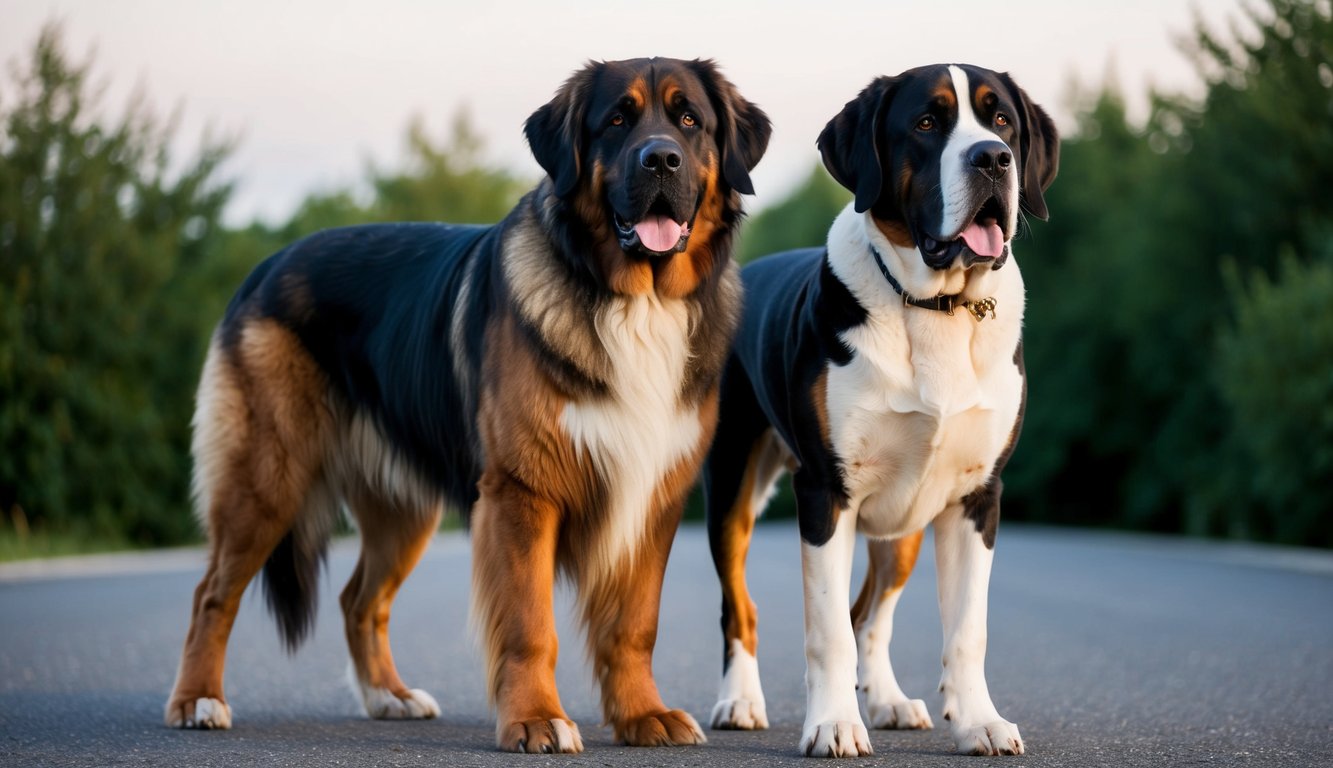The Leonberger and Saint Bernard have fascinating histories rooted in different parts of Europe. Both breeds were developed for specific purposes and have unique origin stories that shaped their characteristics. Let’s take a look at the similarities and differences between these two dog breeds.
If you’re still on the market to buy a Leonberger or Saint Bernard, PuppySpot currently offers a $300 discount using the code PUPPY300, just click the banner below!
Physical Characteristics
Leonbergers and Saint Bernards are both massive dogs with impressive builds. These gentle giants have distinct features that set them apart. Let’s explore their size, weight, and coats in detail.
Assessing Size and Height
- Leonbergers are large dogs that stand tall and proud. Male Leonbergers typically reach 28-31 inches in height at the shoulder. Females are slightly smaller, measuring 25-29 inches.
- Saint Bernards are even bigger. Male Saint Bernards usually stand 28-30 inches tall. Females are a bit shorter, ranging from 26-28 inches.
- Both breeds have a muscular build and broad chest. Their large size makes them stand out in a crowd. You’ll need plenty of space in your home to accommodate these giant breeds comfortably.
Weight Considerations
- Leonbergers are heavy dogs, but Saint Bernards often weigh more. Male Leonbergers typically weigh between 110-170 pounds. Females are lighter, ranging from 90-140 pounds.
- Saint Bernards are heavier, with males weighing 140-180 pounds. Female Saint Bernards usually weigh 120-140 pounds.
- These weights can vary based on diet, exercise, and genetics. It’s crucial to maintain a healthy weight for both breeds to prevent joint issues. Regular vet check-ups can help you keep your giant breed at an ideal weight.

Distinctive Coat Types
Leonbergers have a lion-like appearance thanks to their unique coat. Their double coat is medium to long and water-resistant. Colors range from lion-yellow to red-brown, often with a black mask.
Saint Bernards have two coat varieties:
- Short-haired: Dense, smooth, and close-lying
- Long-haired: Slightly wavy and longer
Saint Bernard coats are typically white with red or brown markings. Both breeds shed a lot, especially during seasonal changes. You’ll need to brush them regularly to keep their coats healthy and your home fur-free.
Temperament and Personality Traits
Leonbergers and Saint Bernards are known for their gentle nature and friendly personalities. These large breeds share many traits that make them popular family pets, but they also have some unique characteristics.
The Leonberger Disposition
- Leonbergers are loving and affectionate dogs with a calm demeanor. They’re patient and good-natured, making them great companions for families. These gentle giants are also intelligent and eager to please their owners.
- Leonbergers have a playful side, especially when young. They enjoy outdoor activities and need regular exercise to stay happy and healthy. You’ll find they’re confident but not aggressive, and they tend to get along well with other pets.
- These dogs are known for their loyalty and can be protective of their families. They’re not typically barkers, but they’ll alert you to potential dangers. Leonbergers are sensitive and respond well to positive reinforcement training methods.
The Saint Bernard Temperament
- Saint Bernards are famous for their gentle and friendly nature. They’re patient, calm, and have a sweet disposition that endears them to many. These dogs are known for their loving and affectionate personality.
- You’ll find Saint Bernards to be steady and reliable companions. They’re not as playful as some breeds but enjoy spending time with their families. These dogs are intelligent but can be a bit stubborn at times, so consistent training is important.
- Saint Bernards have a strong desire to please their owners. They’re generally good with other pets and rarely show aggression. These gentle giants are known for their drooling, which some owners find endearing while others may find it challenging.
Interaction with Children and Families
- Both Leonbergers and Saint Bernards are excellent family pets due to their gentle temperaments. They’re patient with children and can be great playmates for kids of all ages.
- You’ll need to supervise interactions between these large dogs and small children. Their size can accidentally knock over toddlers during play. Both breeds are generally good-natured and tolerant, making them suitable for families with children.
- Leonbergers and Saint Bernards thrive on human companionship and do best when included in family activities. They’re loyal and protective without being aggressive, providing a sense of security to their families. Early socialization is important to ensure they grow into well-mannered adult dogs.

Health and Lifespan
Leonbergers and Saint Bernards face some similar health challenges due to their large size. Both breeds need careful monitoring and preventive care to stay healthy and live long lives.
Common Health Concerns
- Hip and elbow dysplasia are common in both Leonbergers and Saint Bernards. These conditions affect the joints and can cause pain and mobility issues.
- Bloat is another serious concern for both breeds. This stomach condition can be life-threatening if not treated quickly.
- Leonbergers may develop Addison’s disease, an endocrine disorder. Saint Bernards are prone to eye problems like entropion and ectropion.
- Both breeds can suffer from allergies and skin issues. Regular check-ups and a healthy diet help catch problems early.
Managing Breed-Specific Ailments
- To manage hip and elbow dysplasia, keep your dog at a healthy weight. Low-impact exercise like swimming can help maintain joint health.
- For bloat prevention, feed smaller meals throughout the day. Avoid exercise right after eating.
- Regular eye exams are crucial for Saint Bernards. For Leonbergers, watch for signs of Addison’s disease like lethargy or vomiting.
- Both breeds benefit from regular grooming to prevent skin issues. Brush their coats often and check for any lumps or bumps.
Expected Longevity
- The average lifespan for both Leonbergers and Saint Bernards is 8-10 years. With proper care, some may live longer.
- Regular vet check-ups can catch health issues early. A balanced diet and exercise routine are key to longevity.
- Genetic testing can help identify potential health risks. Work with a reputable breeder who screens for hereditary conditions.
- Mental stimulation is important too. Keep your giant breed dog engaged with toys and training to promote overall well-being.
Care and Maintenance
Leonbergers and Saint Bernards need regular grooming, exercise, and a balanced diet. These gentle giants have specific care requirements to keep them healthy and happy.
Grooming Essentials
- Both breeds have thick double coats that need frequent brushing. You should brush your Leonberger’s coat at least 2-3 times a week. Saint Bernards need daily brushing during shedding seasons. Use a slicker brush and metal comb to remove tangles and loose fur.
- Bathe these dogs every 6-8 weeks or when dirty. Clean their ears weekly and trim nails monthly. Wipe facial folds daily to prevent infections.
- Both breeds drool, so keep a cloth handy. Saint Bernards tend to drool more than Leonbergers. You’ll need to clean their jowls often to prevent skin irritation.
Exercise Requirements
- Despite their size, these breeds need regular exercise. Leonbergers are more active and require about 60 minutes of daily exercise. Take them for walks, swims, or play fetch.
- Saint Bernards need 30-60 minutes of daily activity. They enjoy walks and mild play sessions. Be careful not to overexert them, especially in hot weather.
- Both breeds benefit from mental stimulation. Puzzle toys and training sessions help keep their minds sharp.
Feeding and Diet
- Feed your Leonberger or Saint Bernard a high-quality large breed dog food. Divide their daily portion into 2-3 meals to prevent bloat.
- Adult Leonbergers typically need 4-8 cups of food per day. Saint Bernards may require 5-6 cups daily. Adjust amounts based on age, weight, and activity level.
- Monitor their weight closely. Obesity can lead to joint problems in these large breeds. Limit treats and avoid feeding table scraps.
- Provide fresh water at all times. Consider using elevated food and water bowls to reduce neck strain.

Training and Socialization
Leonbergers and Saint Bernards are intelligent and eager to please, making them responsive to training. Both breeds need early socialization and consistent training to become well-mannered companions.
Training Techniques and Obedience
- Leonbergers and Saint Bernards respond well to positive reinforcement methods. Use treats, praise, and toys to reward good behavior. Keep training sessions short and fun to maintain their interest.
- Start with basic commands like sit, stay, and come. As they progress, teach more advanced skills. Leonbergers excel in agility and can learn complex tasks quickly. Saint Bernards may be slower learners but are equally capable.
- Use their strength to your advantage. Teach them to pull carts or sleds as a fun exercise. This also taps into their working dog heritage.
Importance of Socialization
- Early socialization is crucial for both breeds. Expose your puppy to various people, animals, and environments. This helps prevent fearfulness or aggression later in life.
- Take your dog to puppy classes. These provide structured socialization opportunities. Invite friends and family to meet your puppy. Introduce them to different sights, sounds, and textures.
- Continue socializing throughout their life. Regular walks in busy areas help maintain their social skills. Both breeds can be excellent therapy dogs with proper socialization.
Using Positive Reinforcement
- Positive reinforcement is key for training these gentle giants. Reward desired behaviors immediately. This helps your dog understand what you want.
- Use high-value treats for challenging tasks. Praise enthusiastically when they succeed. Avoid harsh corrections, as these can damage your bond.
- Be patient and consistent. Both breeds may have stubborn streaks. Stay calm and redirect unwanted behaviors. Never use physical punishment.
- Clicker training can be effective for both Leonbergers and Saint Bernards. It provides clear communication and precise timing. Pair the click with treats to mark correct behaviors.




